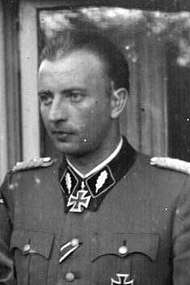Standartenführer
SS-Standartenführer ([ʃtanˈdaʁtn̩.fyːʀɐ], lit. 'standard leader') was a Nazi Party (NSDAP) paramilitary rank that was used in several NSDAP organizations, such as the SA, SS, NSKK and the NSFK.[1][2] First founded as a title in 1925, in 1928 the rank became one of the first commissioned NSDAP ranks and was bestowed upon those SA and SS officers who commanded units known as Standarten which were regiment-sized formations of between three hundred and five hundred men.[1]

| Standartenführer | |
|---|---|
 SS Gorget patches | |
 SS Shoulder and camo insignia | |
| Country | |
| Service branch | |
| Abbreviation | Staf. |
| NATO rank | OF-5 |
| Formation | 1925 |
| Abolished | 1945 |
| Next higher rank | Oberführer |
| Next lower rank | Obersturmbannführer |
| Equivalent ranks | Oberst Kapitän zur See |
In 1929 the rank of Standartenführer was divided into two separate ranks known as Standartenführer (I) and Standartenführer (II). This concept was abandoned in 1930 when both the SA and SS expanded their rank systems to allow for more officer positions and thus the need for only a single Standartenführer rank. In 1933, when Adolf Hitler came to power in Germany, the rank of Standartenführer had been established as the highest field officer rank, lesser than that of Oberführer of the SS and SA. By the start of World War II, Standartenführer was widely spread as both an SS rank and a rank of the SA. In the Waffen-SS, the rank was considered the equivalent of an Oberst, a full colonel.[3]
The insignia for Standartenführer consisted of a single oak leaf displayed on both collars.[4] Standartenführer was the first of the SS and SA ranks to display rank insignia on both collars, without the display of unit insignia.[4] From 1938, newer SS uniforms featured the shoulder boards of a German Army Oberst (colonel) in addition to the oak leaf collar patches.[5]
Insignia


 NSKK gorget patch
NSKK gorget patch NSFK gorget patch
NSFK gorget patch
| Junior Rank Obersturmbannführer |
SS rank and SA rank Standartenführer |
Senior Rank Oberführer |
See also
- Table of ranks and insignia of the Waffen-SS
- Standarte (Nazi Germany)
Notes
- McNab 2009b, p. 15.
- McNab 2009, p. 30.
- Stein 1984, p. 297.
- Flaherty 2004, p. 148.
- Stein 1984, p. 300.
Bibliography
- Flaherty, T. H. (2004) [1988]. The Third Reich: The SS. Time-Life Books, Inc. ISBN 1 84447 073 3.CS1 maint: ref=harv (link)
- McNab, Chris (2009). The SS: 1923–1945. Amber Books Ltd. ISBN 978-1-906626-49-5.CS1 maint: ref=harv (link)
- McNab, Chris (2009b). The Third Reich. Amber Books Ltd. ISBN 978-1-906626-51-8.CS1 maint: ref=harv (link)
- Stein, George (1984) [1966]. The Waffen-SS: Hitler's Elite Guard at War 1939–1945. Cornell University Press. ISBN 0-8014-9275-0.CS1 maint: ref=harv (link)
- Wasser, Bruno: Himmlers Raumplanung im Osten, Basel, Berlin und Boston 1993, Seite 347, ISBN 3-7643-2852-5
- Yerger, Mark C. (1997). Allgemeine-SS: The Commands, Units and Leaders of the General SS. Schiffer Publishing. ISBN 0-7643-0145-4.CS1 maint: ref=harv (link)